Scottish Health Survey 2019 - volume 1: main report
Presents results for the Scottish Health Survey 2019, providing information on the health and factors relating to health of people living in Scotland.
Chapter 8: Adverse Childhood Experiences
In 2019, just over one in seven adults reported four or more ACEs.
- 15% - 4 or more
Verbal abuse was the most common ACE reported, experienced by just under half of all adults.
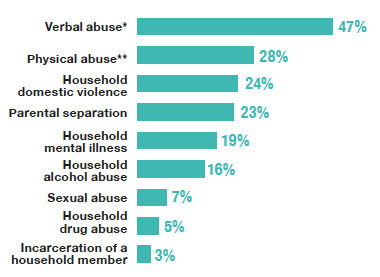
Those in the most deprived areas were almost twice as likely than those in the least deprived areas to experience four or more ACEs.
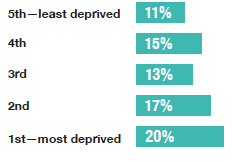
* On SHeS, verbal abuse was scored as an ACE if it was reported as happening once or more, in the Welsh and English studies verbal abuse was scored as an ACE if it was reported as happening twice or more.
** On SHeS, the physical abuse ACE did not exclude 'gentle smacking for punishment' as most other ACE surveys do.
The proportion of adults reporting four or more ACEs in 2019 was higher among those whose parents were in routine and manual occupations ***.
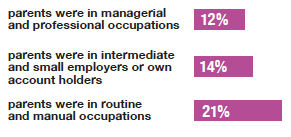
- 12% parents were in managerial and professional occupations
- 14% parents were in intermediate and small employers or own account holders
- 21% parents were in routine 4 or more and manual occupations
Adults who had four or more ACEs were less likely to have a degree level qualification or higher.
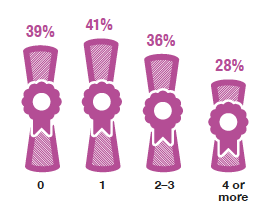
As the number of ACEs reported increased, so did the proportion of adults with no formal qualifications.
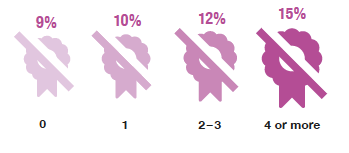
The prevalence of hazardous, harmful or possibly dependent drinking behaviour **** was higher among those who reported one or more ACE's (17–19%) than those who reported no ACE's (11%).
*** When the adult respondent was a child of about 14 years of age.
**** AUDIT scores of 8 or more.
Those who reported four or more ACEs were significantly more likely to be/have/suffer from...
Obesity
- 0 - 29%
- 1 - 31%
- 2-3 - 30%
- 4+ - 39%
Current smokers
- 0 - 10%
- 1 - 10%
- 2-3 - 17%
- 4+ - 27%
A limiting long-term condition *****
- 0 - 26%
- 1 - 30%
- 2-3 - 36%
- 4+ - 52%
Any cardiovascular disease
- 0 - 14%
- 1 - 12%
- 2-3 - 14%
- 4+ - 21%
Not met physical activity guidelines ******
- 0 - 32%
- 1 - 31%
- 2-3 - 33%
- 4+ - 41%
Lower mental wellbeing scores (WEMWBS)
- 0 - 52.0
- 1 - 50.6
- 2-3 - 49.3
- 4+ - 46.0
***** A physical or mental health condition or illness lasting, or expected to last 12 months or more where the respondent has reported that it limited their activities in any way.
****** At least 150 minutes of moderate physical activity, 75 minutes of vigorous physical activity, or an equivalent combination of the two per week.
8 Adverse Childhood Experiences
8.1 Introduction
Increasing evidence and awareness about adverse childhood experiences and the association with poor health and social outcomes has led to calls for Scottish population data in order to increase understanding of childhood adversity in Scotland to inform policy and practice.
Adverse Childhood Experiences (ACEs) can be defined as stressful or traumatic experiences that occur during childhood (between 0 and 18 years of age). The term 'ACEs' was developed in an original study conducted in the United States in 1995-97[1] to assess the association between childhood maltreatment and health and wellbeing later in life. The ten most widely recognised ACEs are based on findings from that study and include:
- being the victim of abuse (physical, sexual and/or emotional) or neglect (physical and emotional)
- growing-up in a household in which there are adults experiencing harmful alcohol and drug use or mental health problems, adults who have spent time in prison, or where there is domestic violence
- parental separation
ACEs can cause harmful stress that can negatively impact on children's healthy development [2] and without the right support, can have a lasting influence on their health and wellbeing and life chances into adulthood[3]. Evidence from ACE studies has found that the health and social risks associated with having ACEs increase with the number of ACEs people report.
Studies on ACEs have been carried out in England[4] and Wales[5] adapted from the ten ACEs questionnaire developed in the United States. Evidence from the 2015 Welsh ACE survey[6],[7] found that compared to people with no ACEs, those with four ACEs or more are statistically:
- 3 times increased risk of heart disease, respiratory disease and type 2 diabetes
- 4 times more likely to be a high-risk drinker
- 5 times more likely to have low mental wellbeing
- 14 times more likely to have been victim of violence in the last 12 months
- 15 times more likely to have committed violence
- 16 times more likely to have used crack cocaine or heroin
- 20 times more likely to have been in prison at any point in their life.
The 2017 Welsh ACE survey[8] found that compared to people with no ACEs, those with four or more ACEs were statistically:
- 3.7 times more likely to currently be receiving treatment for mental illness
- 6.1 times more likely to have ever received treatment for mental illness
- 9.5 times more likely to have ever felt suicidal or self-harmed.
The 2017 ACE survey in Wales also included new questions on resilience and found that having resilience resources, such as a trusted adult relationship during childhood or regular sports participation as a child, more than halved the risk of a current mental illness in adults with four or more ACEs[9].
Whilst the association between ACEs and poor outcomes is identified in population surveys and wider evidence, individuals' experience of adversity and how they respond will depend on a range of factors, including the existence of supportive relationships and access to financial and other resources. Therefore, it is not possible to determine an individual's longer-term health or other life outcomes based on the number of ACEs they have experienced. However, increasing our understanding of ACEs at a population level, through surveys, is important for gauging the societal prevalence of ACEs and understanding how this is impacting on health, wellbeing and other outcomes.
A recent study[10] explored experiences of adversity in children in Scotland using secondary analysis of data collected in the Growing Up In Scotland cohort study (GUS)[11]. Whilst different questions to those in the above ACE studies are used in GUS, the data available enabled some aspects of ACEs to be assessed by using a range of proxy measures across seven types of ACEs: physical abuse, domestic violence, substance abuse, mental illness, parental separation, parental incarceration and emotional neglect. The study suggests that by 8 years of age, two-thirds of Scottish children will have experienced one or more ACE-related factors and one in ten will have experienced three or more ACE-related factors. It also found an association between the experiences of adversity captured in the survey and poverty, with children living in disadvantaged circumstances more likely to experience ACE-related factors than their more affluent peers. A systematic review of evidence[12] on the relationship between childhood socio-economic position (SEP) and ACEs concluded that overall, there is a clear relationship between SEP in childhood and the risk of experiencing ACEs.
8.1.1 Policy background
Preventing childhood adversity and reducing the negative impacts of ACEs is a broad agenda which is progressed across many Ministerial portfolios. It contributes to a wide range of the national outcomes set out in the National Performance Framework and is particularly aligned to the national outcome that 'we grow up loved, safe and respected so that we realise our full potential'.
Tackling the impact of ACEs is a priority for the Scottish Government which made a commitment in its 2017 to 2018 Programme for Government to prevent and mitigate ACEs and to support those affected. This commitment was anchored in the long-standing national approach of Getting It Right For Every Child and was also about better supporting adults affected by childhood adversity.
In addition to the adversities commonly measured in ACE surveys, the Scottish Government recognises that there are a wide range of other adverse experiences that can also negatively impact on children's healthy development; for example, bereavement, bullying, coercive control, homelessness, and community violence. Therefore, the Scottish Government is taking a broad approach to addressing the wide-range of adversities which can impact on children's healthy development, and the related socio-economic factors which impact on levels of adversity experienced, including poverty and gender inequality. The SHeS and other ACE surveys include a question about domestic violence, but it is important to highlight that policy and legislation in Scotland and actions related to ACEs are focused on a broader range of abusive behaviours as reflected in the Domestic Abuse (Scotland) Act 2018.
The 2018 to 2019 Programme for Government built on this commitment, and set out four areas for action on ACEs:
- Provide inter-generational support for parents, families and children to prevent ACEs such as through the tackling child poverty programme and Family Nurse Partnership Programme;
- Reduce the negative impact of ACEs for children and young people such as investment in school counselling services and the development of Barnahus concept for child victims;
- Develop adversity and trauma-informed workforce and services including the National Trauma Training Programme and Education Scotland's work to support nurture and relationship-based approaches in schools;
- Increase societal awareness and supporting action across communities such as working with Public Health Scotland and the Scottish ACEs Hub to raise awareness and understanding about ACEs, linking to local ACE hubs across Scotland.
The 2019 to 2020 Programme for Government reiterated the commitment to these four areas of action and to addressing the wide range of childhood adversities that can have a detrimental effect on children's healthy development. The most recent Programme for Government for 2020 to 2021[13] outlined a range of commitments related to this agenda, including commitments to progressing children's rights and the Incorporation of United Nations Convention on the Rights of the Child (UNCRC) Bill, tackling child poverty, fulfilling the Independent Care Review (The Promise), supporting families, and expansion of the National Trauma Training Programme
8.1.2 Reporting on adverse childhood experiences in the Scottish Health Survey (SHeS)
This chapter provides information on ACEs for adults aged 18 and over. Prevalence of ACEs is reported by individual types of ACEs as well as by number of ACEs up to four or more by age and sex. Prevalence of four or more ACEs is reported by deprivation, educational qualification, parental socio-economic classification, health risk behaviours, mental wellbeing, long term conditions and cardiovascular disease and diabetes.
The area deprivation data are presented in Scottish Index of Multiple Deprivation (SIMD) quintiles. To ensure that the comparisons presented are not confounded by the different age profiles of the quintiles, the data have been age-standardised. Data on ACE prevalence is also explored in relation to parental socio-economic classification (SEC), physical activity levels and mental wellbeing (WEMWBS).
Readers should refer to the Glossary at the end of this Volume for a detailed description of SIMD, parental SEC, WEMWBS and age-standardisation.
Supplementary tables on mental wellbeing are also published on the Scottish Health Survey website[14].
8.2 Methods and Definitions
8.2.1 Adverse Childhood Experiences Questionnaire
ACE questions were included in the 2019 SHeS survey following recommendations made during the 2017 consultation[15] on the Scottish Health Survey content by NHS Health Scotland and the Glasgow Centre for Population Health, with input from Glasgow Health and Social Care Partnership and supported by the GPs at the Deep End steering group and the Health and Social Care Alliance Scotland (the ALLIANCE). The proposed questions were based on the ACEs questionnaire developed for the US-based Centers for Disease Control-Kaiser ACE[16] study with minor adaptations made to suit a Scottish context.
Due to interview time constraints it was not possible to include all the recommended questions in the SHeS 2019, therefore questions on bullying and neglect were not included. A further adaptation for the Scottish context was the removal of the words 'This does not include gentle smacking for punishment' from the physical abuse question to reflect the introduction of legislation related to smacking in Scotland (the Children (Equal Protection from Assault) (Scotland) Act).
The full list of questions used in the SHeS 2019 questionnaire are detailed below.
| Question |
Answer options |
|---|---|
| How often did a parent or adult in your home ever swear at you, insult you, or put you down? How often did your parents or adults in your home ever slap, hit, kick, punch or beat each other up? How often did a parent or adult in your home ever hit, beat, kick or physically hurt you in any way? How often did anyone at least 5 years older than you (including adults) ever touch you – or try to make you touch them – sexually? How often did anyone at least 5 years older than you (including adults) force you to have any type of sexual intercourse (oral, anal or vaginal)? |
|
| Did you live with anyone who was depressed, mentally ill or suicidal? Did you live with anyone who was a problem drinker or alcoholic? Did you live with anyone who used illegal street drugs or who abused prescription medications? Did you live with anyone who served time or was sentenced to serve time in a prison or a young offenders' institution? Were your parents ever separated or divorced? |
|
For questions with a yes/no answer option, the answer 'yes' constitutes an ACE. For questions with never, once or twice, sometimes, often or very often, the answer 'once or twice' or more constitutes an ACE. This differs from the Welsh[17] and English[18] surveys in one respect. In the Welsh and English surveys for the verbal abuse question 'How often did a parent or adult in your home ever swear at you, insult you, or put you down?', more than once constituted an ACE.
It should also be noted that only those who provided answers to all the above questions were included in the analysis. An accurate calculation of the number of ACEs for individuals with data missing for any of the questions was not possible.
The age range of SHeS participants (adults aged 18 and over) is wider than that for the Welsh and English ACE studies (adults aged 18-69). Also, the ACE questions in SHeS were asked as part of the paper self-completion questionnaire (returned in a sealed envelope by interviewers) whereas the other UK surveys utilised a computer assisted self-completion (CASI) approach where participants (limited to one per household) completed the questions (one question per screen) themselves on a laptop.
Caution should therefore be used in making direct comparisons between the ACE data reported in SHeS and the ACE data reported in the English 2014 and Welsh 2015 ACE studies.
The Welsh ACE survey in 2017 included questions to capture experiences of emotional and physical neglect (not included in the 2015 Welsh ACE survey or this SHeS). The absence of questions on neglect is unlikely to have impacted on the overall prevalence of 4 or more ACEs in this year's SHeS, as neglect tended to be reported in the Welsh survey as co-occurring with another ACE rather than on its own[19].
This was the first time ACE questions have been included in the SHeS or any population survey in Scotland; learning from this survey exercise will inform development of ACE questions for the next SHeS and any future rounds.
8.3 Adverse Childhood Experiences (ACEs)
8.3.1 Prevalence of individual ACEs in adults, 2019, by age and sex
In 2019, the most prevalent individual ACE reported among adults aged 18 and over was verbal abuse (47%)[20]. The next most commonly reported ACEs were physical abuse[21] (28%), household domestic violence (24%) and/or parental separation (23%). Household mental illness and household alcohol abuse ACEs were a little less prevalent, reported by 19% and 16% of adults respectively. The remaining ACEs were reported by fewer than one in ten adults: 7% reported sexual abuse, 5% reported household drug abuse and 3% reported incarceration of a household member.
Prevalence of individual ACEs in adults, 2019
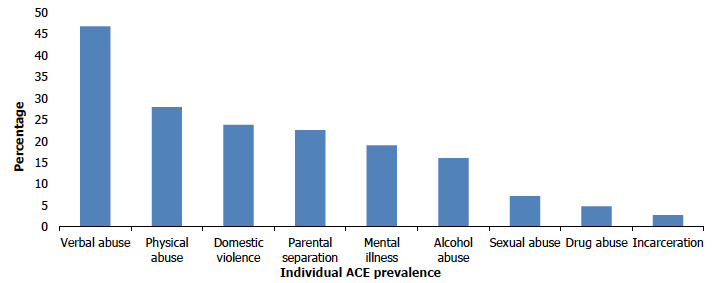
Experience of verbal abuse, physical abuse and household domestic violence ACEs was higher among men than women; 50% and 44% respectively for verbal abuse, 32% and 24% respectively for physical abuse and 27% and 21% respectively for household domestic violence.
The prevalence of the childhood sexual abuse ACE was higher among women than among men (10% and 4% respectively), as was the proportion of women experiencing the household mental illness ACE (22% compared with 16% among men).
Among all adults, prevalence of the individual ACEs varied by age apart from the incarceration of a household member ACE. The proportion who had experienced parental separation decreased with age, with those aged 18-24 (39%) seven times more likely to report this ACE than those aged 75 and over (6%). A similar pattern was found for men and women.
Similarly, adults aged 18-34 were around six times more likely to have reported a household mental illness ACE than those aged 75 and over (29 - 30% and 5% respectively) with similar patterns for women and men.
The prevalence of those reporting a household domestic violence ACE and those reporting a physical abuse ACE in 2019 initially increased with age, from 12% and 15% respectively among those aged 18-24 to the highest prevalence among those aged 45-54 (32% and 35% respectively) then decreased to 15% and 17% respectively among those aged 75 and over. These patterns by age were similar for women and men.
Reporting of a household alcohol abuse ACE was relatively consistent up to age 44 (15 - 16% among those aged 18-44) with an increase to 21% among those aged 45-54 before decreasing to 9% among those aged 75 and over. This pattern by age was found for both men and women.
The prevalence of the verbal abuse ACE was highest among those aged 18-54 (51 - 56%) with prevalence then decreasing with age to 26% among those aged 75 and over. A similar pattern was found for men and women.
Experience of the sexual abuse or incarceration of a household member ACEs did not differ significantly by age. Figure 8A, Table 8.1
8.3.2 ACE count in adults, 2019, by age and sex
In 2019, just over seven in ten adults (71%) reported having experienced at least one ACE, while 15% reported four or more ACEs. Prevalence of four or more ACEs was similar for men and women (14% and 16% respectively).
However, differences were evident by age, with higher prevalence of four or more ACEs reported by those aged 18-64 (15 - 19%) compared with those aged 65-74 (8%) and those aged 75 and over (5%).
Around three in ten adults (29%) reported no ACEs. This proportion was relatively consistent among all adults aged 54 and under (22 - 24%) before increasing with age to the highest prevalence of 49% among those aged 75 and over. Figure 8.B, Table 8.2
ACE count in all adults, 2019
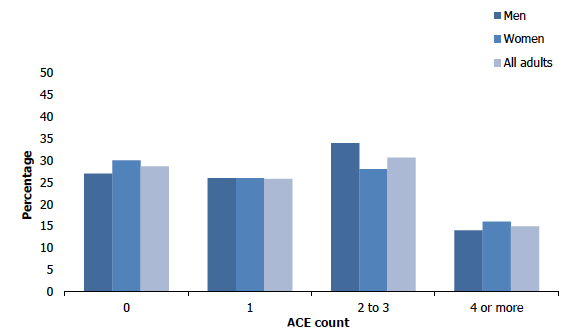
8.3.3 ACE count in adults (age-standardised), 2019, by area deprivation and sex
Those in the most deprived areas were almost twice as likely than those in the least deprived areas to experience four or more ACEs (20% compared to 11% respectively). This difference was evident for men and women. Figure 8.C, Table 8.3
ACE count (age-standardised), 2019, by area deprivation ( SIMD quintiles)
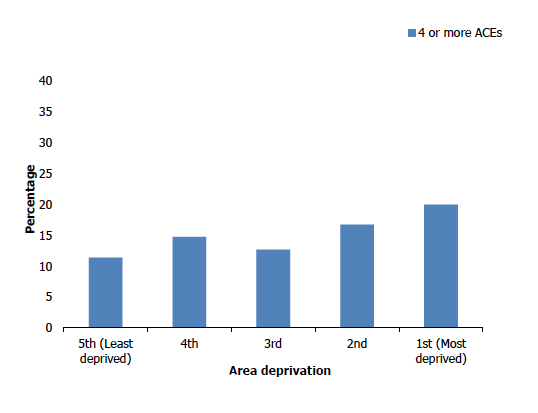
8.3.4 ACE count (age-standardised), 2019, by parental socioeconomic classification (SEC) in adults and sex
The proportion of adults reporting four or more ACEs in 2019 rose from 12% among those whose parents were in managerial and professional occupations[22] and 14% among those in intermediate and small employers or own account holders to 21% among those whose parents were in routine and manual occupations. This association was evident among both men and women. Table 8.4
8.3.5 Highest qualification in adults (age-standardised), 2019, by ACE count and sex
Adults who had four or more ACEs were less likely to have a degree level qualification or higher (28%) than those of those who had fewer or no ACEs (36 - 41%). This pattern was evident for both men and women.
As the number of ACEs reported increased, so did the proportion of adults with no formal qualifications (from 9% among those with no ACEs to 15% among those with four or more ACEs). This linear relationship was evident among men (from 7% among those with no ACEs to 18% among those with four or more ACEs) however there was no equivalent relationship among women.
There was no clear pattern by ACE count for the other qualification levels. Table 8.5
8.3.6 Risk behaviours in adults (age-standardised), 2019, by ACE count and sex
Adults who reported four or more ACEs were more likely to be obese (39%) than those with fewer or no ACEs (29 - 31%). A similar pattern was evident for men (36% among those with four or more ACEs compared to 28 - 31% among those with fewer or no ACEs) and women (42% among those with four or more ACEs compared to 30 - 31% among those with fewer or no ACEs).
Prevalence of obesity (age-standardised), 2019, by ACE count and sex
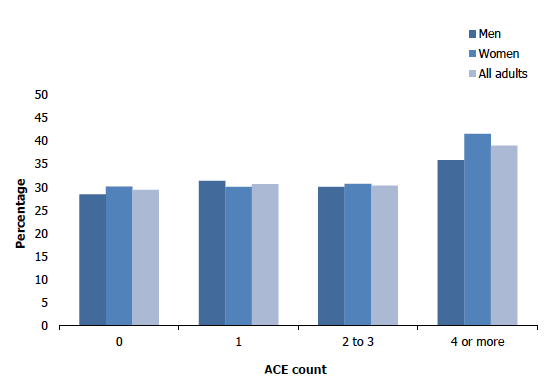
The prevalence of current smoking among all adults increased in line with ACE count from 10% among those with no ACEs or one ACE to 17% among those with two or three ACEs and 27% among those with four or more ACEs. Similar patterns were found for men and women.
Current cigarette smoking (age-standardised), 2019, by ACE count and sex
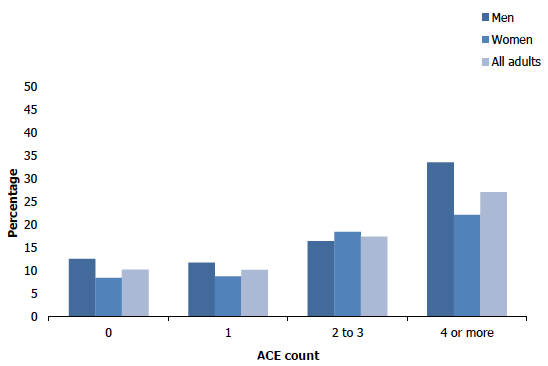
The proportion of those who did not meet physical activity guidelines was highest among those who reported four or more ACEs (41%) compared with a range of 31 - 33% among those with fewer or no ACEs, a marginally significant relationship. Similar patterns were found for men and women.
Proportion not meeting physical activity guidelines (age-standardised), 2019, by ACE count and sex
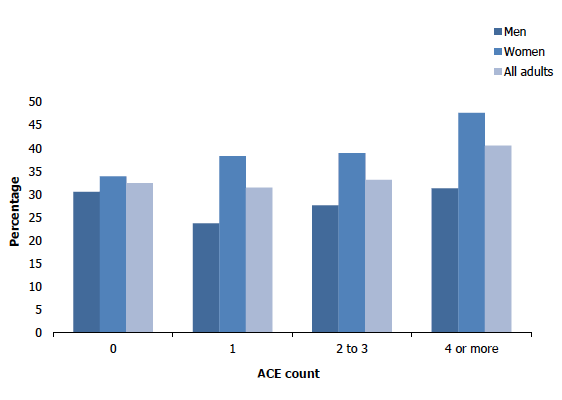
Drinking more than the recommended maximum number of units of alcohol per week did not differ significantly by ACE count (further analysis of ACE count by alcohol consumption is provided in section 8.3.8).Figures 8.D, 8.E & 8.F, Table 8.6
8.3.7 Number of health-related risk behaviours in adults (age-standardised), 2019, by ACE count and sex
The number of health-related risk behaviours[23] reported by adults in 2019 varied by ACE count.
Among those who reported any ACEs, step-increases in the proportion recording two or more risk behaviours were evident, rising from 23% of those reporting one ACE to 31% among those reporting two or three
ACEs and then again to 43% among those with four or more ACEs.
Conversely, a lower proportion of those with four or more ACEs reported no risk behaviours (24%) than those with fewer or no ACEs (30 - 36%). Similar patterns were found for men and women. Figure 8.G, Table 8.7
Number of health-related risk behaviours (age-standardised), 2019, by ACE count
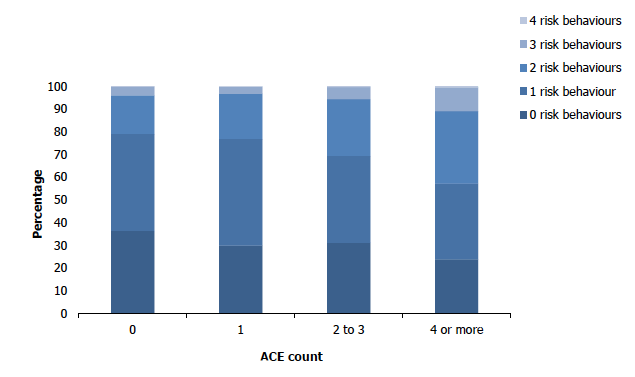
8.3.8 AUDIT scores (age-standardised), 2019, by ACE count and sex
The prevalence of hazardous, harmful or possibly dependent drinking behaviour varied by whether any ACEs were reported or not. The proportion of adults with an AUDIT score of 8 or more[24] was higher among those who reported one or more ACE than those with no ACEs (17 - 19% compared with 11% respectively). Table 8.8
8.3.9 Adult WEMWBS mean score (age-standardised), 2019, by ACE count and sex
Those with four or more ACEs had lower mental wellbeing (as measured by mean WEMWBS scores) than those with fewer or no ACEs. Mean WEMWBS scores decreased from an average of 52.0 among those with no ACEs to 50.6 among those with one ACE, 49.3 among those with two or three ACEs and to the lowest score of 46.0 among those with four or more ACEs[25]. This relationship was evident for both men and women. Figure 8.H, Table 8.9
Adult WEMWBS mean score (age-standardised), 2019, by ACE count and sex
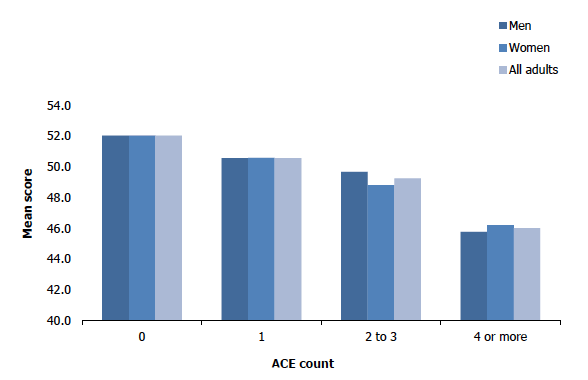
8.3.10 Prevalence of long-term conditions in adults (age-standardised), 2019, by ACE count and sex
As ACE count increased, so did the proportion of adults living with at least one limiting long-term condition[26]; from around a quarter of adults with no ACEs (26%) to around half of those with four or more ACEs (52%). The increase in prevalence between those who reported two or three ACEs (36%) and those who reported four or more (52%) was particularly marked (sixteen percentage points). This pattern was evident for both men and women.
Limiting long-term condition (age-standardised), 2019, by ACE count and sex
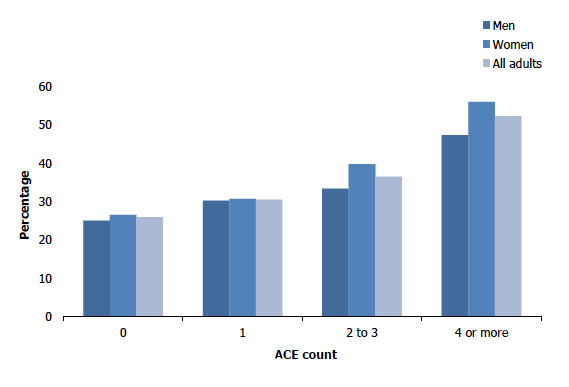
There was no clear relationship between ACE count and age-standardised prevalence of non-limiting long-term health conditions[27] in 2019. However, the number of ACEs reported was inversely associated with the likelihood of no long-term conditions being reported, a proportion that decreased from 61% among those with no ACEs to 37% among those with four or more ACEs. Again, this pattern was evident among both men and women.
A higher proportion of adults with four or more ACEs reported having any cardiovascular disease (CVD)[28] (21%) compared with those with fewer or no ACEs (12 - 14%). This pattern was evident for both men and women.
The proportion of adults who had had a stroke was significantly associated with the number of ACEs reported; those with no ACEs reported were more likely to have reported having had a stroke than those who reported one ACE or more (4% compared with 2% respectively). A similar pattern was found for men, however for women there was no clear pattern.
Those with no ACEs reported were also more likely to have ischaemic heart disease (IHD) than those who reported one ACE or more (6% compared with 3 - 4% respectively). A similar pattern was evident for men and women.
The number of ACEs reported was not significantly associated with the prevalence of diabetes. Figure 8.I, Table 8.10
Table List
Table 8.1 Prevalence of individual ACES in adults, 2019, by age and sex
Table 8.2 ACE count in adults, 2019, by age and sex
Table 8.3 ACE count (age-standardised), 2019, by area deprivation and sex
Table 8.4 ACE count (age-standardised), 2019, by parental socio-economic classification (SEC) in adults and sex
Table 8.5 Highest qualification in adults (age-standardised), 2019, by ACE count and sex
Table 8.6 Risk behaviours in adults (age-standardised), 2019, by ACE count and by sex
Table 8.7 Number of risk health-related behaviours in adults (age-standardised), 2019, by ACE count and sex
Table 8.8 AUDIT scores (age-standardised), 2019, by ACE count and by sex
Table 8.9 Adult WEMWBS mean score (age-standardised), 2019, by ACE count and sex
Table 8.10 Prevalence of long-term conditions in adults (age-standardised), 2019, by ACE count and sex
The tables can be found on the main report page under supporting files:
https://www.gov.scot/publications/scottish-health-survey-2019-volume-1-main-report/
References and notes
1. Felliti VJ et al. (2008). Relationship of Childhood Abuse and Household Dysfunction to Many of the Leading Causes of Death in Adults: The Adverse Childhood Experiences (ACE) Study. American Journal of Preventative Medicine; 14(4): 245-258.
2. Public Health Scotland (2020). Ending childhood adversity: A public health approach. Edinburgh: Public Health Scotland. Available from: http://www.healthscotland.scot/media/3107/ending-childhood-adversity-a-public-health-approach.pdf
3. Scottish Public Health Network (2016). 'Polishing the Diamonds' Addressing Adverse Childhood Experiences in Scotland. Available from: https://www.basw.co.uk/system/files/resources/basw_91944-2_0.pdf
4. Bellis M. Adverse Childhood Experiences, Resilience and Equity – Setting course for a healthier Wales. Presentation at NHS Health Scotland Conference, Polishing our Gems: A call for action on childhood adversity, November 2016. Available from: http://www.healthscotland.scot/media/1267/2_mark-bellis-presentation.pdf
5. See: http://www.wales.nhs.uk/sitesplus/888/page/88517
6. Public Health Wales (2015). ACEs and their impact on health-harming behaviours in the Welsh adult population. Available from: https://www.wao.gov.uk/sites/default/files/ACE%20Report%20FINAL%20%28E%29.pdf
7. Public Health Wales (2016). Adverse Childhood Experiences and their association with Mental Well-being in the Welsh adult population. Available from: http://www2.nphs.wales.nhs.uk:8080/PRIDDocs.nsf/7c21215d6d0c613e80256f490030c05a/9a2fe7f1e063c61b80257fdc003ab86f/$FILE/ACE%20&%20Mental%20Well-being%20Report%20E.pdf
8. Public Health Wales (2018) Sources of resilience and their moderating relationships with harms from adverse childhood experiences. Available from: https://www.wales.nhs.uk/sitesplus/documents/888/ACE%20&%20Resilience%20Report%20(Eng_final2).pdf
9. Public Health Wales (2018) Sources of resilience and their moderating relationships with harms from adverse childhood experiences. Available from: https://www.wales.nhs.uk/sitesplus/documents/888/ACE%20&%20Resilience%20Report%20(Eng_final2).pdf
10. Marryat L, Frank J (2019). Factors associated with adverse childhood experiences in Scottish children: a prospective cohort study. BMJ Paediatrics Open; 3:e000340. doi:10.1136/bmjpo-2018-000340. Available from: https://bmjpaedsopen.bmj.com/content/3/1/e000340
11. See: https://growingupinscotland.org.uk/
12. Walsh D, McCartney G, Smith M and Armour G. (2019) The Relationship between childhood socio-economic position and Adverse Childhood Experiences (ACEs): a systematic review. Journal of Epidemiology and Community Health, volume 73. Available from: https://jech.bmj.com/content/73/12/1087
13. Protecting Scotland, Renewing Scotland - The Scottish Government's Programme for Scotland 2020-21. Edinburgh, Scottish Government. 2020. Available from: https://www.gov.scot/publications/protecting-scotland-renewing-scotland-governments-programme-scotland-2020-2021/
14. See: www.gov.scot/scottishhealthsurvey
15. Questionnaire Content of the Scottish Health Survey: Consultation Analysis Report. Edinburgh, Scottish Government. 2017. Available from: https://consult.gov.scot/population-health/scottish-health-survey/results/shs-analysisreport.pdf
16. Felitti, V., Anda, R. & Nordenberg, D. (1998) Relationship of childhood abuse and household dysfunction to many of the leading causes of death in adults: The Adverse Childhood Experiences (ACE) study. American Journal of Preventive Medicine 14(4). Available at: https://www.ajpmonline.org/article/S0749-3797(98)00017-8/fulltext
17. Public Health Wales (2015). ACEs and their impact on health-harming behaviours in the Welsh adult population. Available from: https://www.wao.gov.uk/sites/default/files/ACE%20Report%20FINAL%20%28E%29.pdf
18. Bellis, MA, Hughes, K, Leckenby, N, Perkins, C and Lowey, H. (2014). National household survey of adverse childhood experiences and their relationship with resilience to health-harming behaviors in England. BMC Medicine 12(72). Available from: https://bmcmedicine.biomedcentral.com/articles/10.1186/1741-7015-12-72
19. Public Health Wales (2018) Sources of resilience and their moderating relationships with harms from adverse childhood experiences. Available from: https://www.wales.nhs.uk/sitesplus/documents/888/ACE%20&%20Resilience%20Report%20(Eng_final2).pdf
20. On SHeS, verbal abuse was scored as an ACE if it was reported as happening once or more, in the Welsh and English studies verbal abuse was scored as an ACE if it was reported as happening twice or more.
21. On SHeS, the physical abuse ACE did not exclude 'gentle smacking for punishment' as most other ACE surveys do.
22. When the adult respondent was a child of about 14 years of age.
23. In table 8.7 risk behaviours include drinking above recommended maximum, being obese, being a current cigarette smoker and undertaking low or very low levels of physical activity (see details in Table 8.7 and chapters 1 (General Health, CVD and Diabetes), 5 (Smoking) and 7 (Physical Activity) for more on these definitions).
24. Based on the Alcohol Use Disorders Identification Test (AUDIT) scale primarily used to screen for levels of alcohol dependency or high-risk alcohol use, see Chapter 4 Alcohol for details.
25. The mean WEMWBS score for adults in 2019 was 49.8.
26. Defined as a physical or mental health condition or illness lasting or expected to last 12 months or more where the respondent has reported that it limited their activities in any way. See Glossary for further details.
27. Defined as a physical or mental health condition or illness lasting, or expected to last 12 months or more where the respondent has not reported that it limited their activities in any way).
28. See chapter 1 (General Health, CVD and Diabetes) for definitions of these conditions used in SHeS.
Contact
There is a problem
Thanks for your feedback